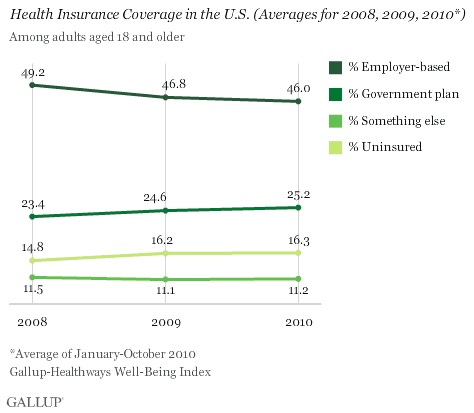WASHINGTON, D.C. -- While many voters cast their ballots for representatives who likely hold a strong position either for or against the healthcare legislation signed into law in March, Gallup finds more than one in six American adults remain uninsured, unchanged from prior months this year, but still significantly more than in 2008, when Gallup and Healthways began tracking it.

The percentage of uninsured Americans shot up to 15.8% in November 2008, in the midst of the financial crisis, and entered into the 16% range in early 2009.
Gallup asks Americans about their healthcare coverage daily as part of the Gallup-Healthways Well-Being Index. The monthly data for October are based on interviews with more than 30,000 Americans.
The close to 300,000 surveys Gallup has conducted so far in 2010 find an average of 16.3% of Americans reporting being uninsured at the time they were interviewed. More Americans on average have government healthcare and fewer have employer-based coverage so far in 2010 compared with 2009 and 2008.

Bottom Line
Several major provisions of the new healthcare law, which could significantly affect coverage in America, were initiated little more than a month ago. These include letting children up to age 26 remain on their parents' plan, banning insurers from canceling a person's coverage if they get sick, and ending lifetime dollar limits on coverage. Gallup trends reveal, however, that these new policies have yet to influence the health coverage situation for the average American, although the changes may take some time to permeate the population. Additionally, the more significant measures designed to reduce the ranks of the uninsured, such as the requirement that most Americans carry health insurance and the creation of health insurance exchanges, are not set to go into effect until 2014.
The results of Tuesday's midterm elections may ultimately affect whether the reforms in the Affordable Care Act may have a chance to help more Americans get healthcare. Numerous Republican and Tea Party candidates have campaigned against the healthcare overhaul and the official 2010 Republican Agenda pledges to "repeal and replace" the current version of the healthcare bill. Regardless of the outcome of Tuesday's elections and the healthcare policies the new Congress pursues, Gallup and Healthways will continue to monitor health insurance coverage in the United States and regularly report updates on Gallup.com.
About the Gallup-Healthways Well-Being Index
The Gallup-Healthways Well-Being Index tracks U.S. well-being and provides best-in-class solutions for a healthier world. To learn more, please visit well-beingindex.com.
Survey Methods
Results are based on telephone interviews conducted as part of the Gallup-Healthways Well-Being Index survey Oct. 1-31, 2010, with a random sample of 30,267 adults, aged 18 and older, living in all 50 U.S. states and the District of Columbia, selected using random-digit-dial sampling.
For results based on the total sample of national adults, one can say with 95% confidence that the maximum margin of sampling error is ±1 percentage point.
Interviews are conducted with respondents on landline telephones and cellular phones, with interviews conducted in Spanish for respondents who are primarily Spanish-speaking. Each daily sample includes a minimum quota of 150 cell phone respondents and 850 landline respondents, with additional minimum quotas among landline respondents for gender within region. Landline respondents are chosen at random within each household on the basis of which member had the most recent birthday.
Samples are weighted by gender, age, race, Hispanic ethnicity, education, region, adults in the household, cell phone-only status, cell phone-mostly status, and phone lines. Demographic weighting targets are based on the March 2009 Current Population Survey figures for the aged 18 and older non-institutionalized population living in U.S. telephone households. All reported margins of sampling error include the computed design effects for weighting and sample design.
In addition to sampling error, question wording and practical difficulties in conducting surveys can introduce error or bias into the findings of public opinion polls.
For more details on Gallup's polling methodology, visit https://www.gallup.com/.
